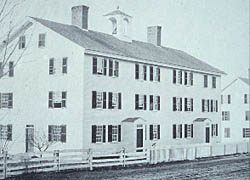Alfred Shaker Historic District | |
 Main buildings, Shaker Village; from a 1915 postcard | |
| Location | Shaker Hill Road. Alfred, Maine |
|---|---|
| Coordinates | 43°29′55″N70°42′41″W / 43.49861°N 70.71139°W |
| Architectural style | Federal |
| NRHP reference No. | 01000371 [1] |
| Added to NRHP | April 11, 2001 |
| Community | Alfred Shaker Historic District [2] |
|---|---|
| Dates | 1793-1931 |
| Bishopric | Alfred |
| Spiritual name | Holy Ground |
| Families | Church, Second, North |
| Maximum population | 200 in 1823 |
 |
| Topics |
|---|
| Notable people |
Founders
Other members |
Alfred Shaker Historic District is a historic district in Alfred, Maine, with properties on both sides of Shaker Hill Road. The area had its first Shaker "believers" in 1783 following visiting with Mother Ann Lee and became an official community starting in 1793 when a meetinghouse was built. It was home to Maine's oldest and largest Shaker community. Two notable events were the songwriting of Joseph Brackett, including, according to most accounts, Simple Gifts , and the spiritual healing of the sick by the Shakers. When the Alfred Shakers products and goods were no longer competitive with mass-produced products and the membership had dwindled significantly, the village was closed in 1931 and members moved to Sabbathday Lake Shaker Village, also in Maine.
Contents
- Shaker village
- History
- Alfred Shaker Museum
- Brothers of Christian Instruction
- See also
- Further reading
- References
- External links
In memory of the influence that the Shaker village had on the community, the Shaker Village Museum was founded by the Friends of the Alfred Shaker Museum and in 2001 the village, or historic district, was added to the National Register of Historic Places.
In 1931 the farmland, village and buildings were acquired by the Brothers of Christian Instruction, now called the Notre Dame Spiritual Center.

